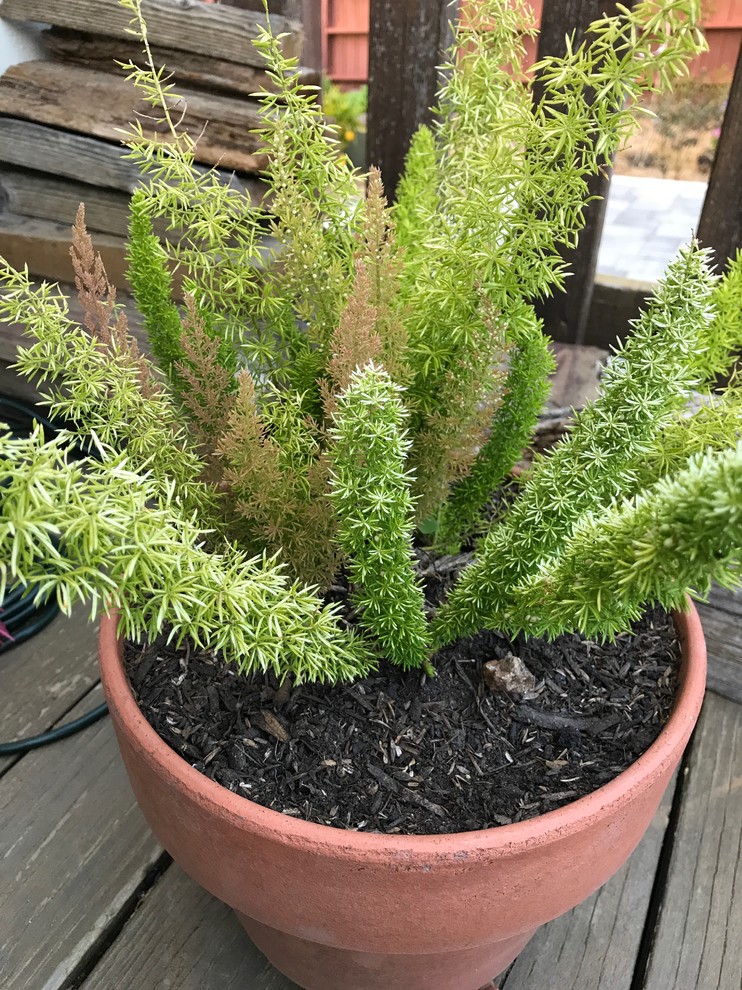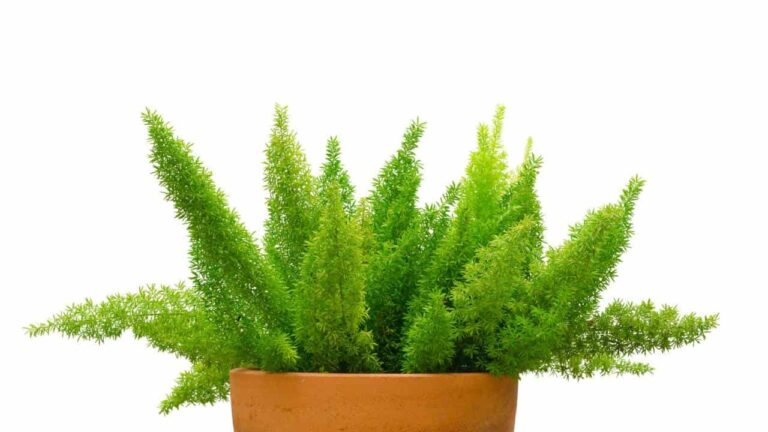Proper Watering Techniques
Watering ferns properly is key to their successful growth. Understanding the balance between overwatering and underwatering ensures healthy, vibrant plants.
Signs of Overwatering and Underwatering
Overwatering and underwatering are common issues that can adversely affect fern plants. Recognizing the signs of each is essential to adjust your watering habits accordingly.
Signs of Overwatering:
- Green or grey mossy growth on the top of the soil indicates waterlogging.
- The presence of root rot or fungal diseases.
Signs of Underwatering:
- Wilting or drooping leaves.
- Dry, brittle fronds that may turn brown (fern plant turning brown).
| Condition | Symptoms | Potential Issues |
|---|---|---|
| Overwatering | Green/grey moss, root rot, fungal diseases | Damaged roots, stunted growth |
| Underwatering | Wilting, dry/brittle fronds | Leaf drop, dying plant |
Importance of Consistent Moisture
Consistent moisture is imperative for the health of fern plants. Ferns have a shallow root system and thin, wiry roots that absorb moisture efficiently. (Plant Addicts).
- Weekly Watering: Without regular rainfall, ferns need weekly watering. The soil should remain moist but not waterlogged.
- Humidity Maintenance: Ferns thrive in tropical-like humid conditions. For indoor ferns, misting a couple of times a week helps maintain required humidity levels. Similarly, misting outdoor ferns on hot days is beneficial (Plant Addicts).
For more insights on maintaining proper fern plant care, visit fern plant care and explore other related articles such as fern plant light requirements and fern plant care in winter.
Utilizing these practices and understanding the needs of your fern ensures lush, vigorous growth. Keep these watering techniques in mind to avoid common pitfalls and foster an ideal environment for your plants.
Watering Guidelines for Ferns
Watering is a crucial factor in the successful care of fern plants. Ensuring the right frequency and utilizing best practices can help keep these plants healthy and vibrant.
Frequency and Timing
Fern plants thrive in consistently moist soil. They prefer tropical-like humid conditions, and weekly watering is typically necessary, especially in the absence of regular rainfall. The soil should not be allowed to completely dry out. To determine the need for watering, one can check the soil moisture by sticking a finger about 1-2 inches into the soil. If it feels dry at that depth, it’s time to water the fern (Plants for all Seasons).
| Fern Type | Watering Frequency | Notes |
|---|---|---|
| Typical Ferns | Once a week | Ensure soil is consistently moist but not soggy |
| Boston Ferns | Every 7-10 days | Allow soil to dry out between waterings (Lively Root) |
Best Watering Practices
To achieve the best results while watering ferns, follow these practices:
- Avoid Overwatering and Underwatering: Signs of overwatering include wilted yellow leaves, leaf drop, and green mossy growth on the soil’s surface. Underwatering can lead to reduced growth, wilting, and shriveling leaves. Monitor your plants for these signs to adjust your watering routine accordingly.
- Water at the Base: Pour water directly at the base of the plant, ensuring the soil is evenly wet. This minimizes the risk of fungal diseases that can be caused by splashing water on the leaves (Plants for all Seasons).
- Check Soil Moisture Regularly: Before watering, check the soil moisture by feeling the top 1-2 inches of soil. If it feels dry, it’s time to water.
- Weight Check: A lightweight container indicates dry soil. Lifting the pot can help you determine if the plant needs watering.
Utilizing these practices will help maintain the health of your fern plants. For more detailed information on fern plant care, please visit our article on fern plant care.
By following these guidelines, you can ensure that your fern plants receive the appropriate amount of water, keeping them lush and vibrant throughout the year. For additional tips and insights, explore our resources on fern plant care outdoor and fern plant care in winter.
Preventing Watering Issues
To ensure the health and vitality of fern plants, it’s crucial to address potential watering issues. Two significant factors to consider are drainage and humidity.
Drainage Considerations
Ferns have a shallow root system and demand consistently moist soil to flourish. Overwatering, however, can lead to root rot or fungal diseases (Plant Addicts). It’s essential to have proper drainage in place to avoid soggy soil and standing water.
- Drainage Holes: Ensure the pot has adequate drainage holes to allow excess water to escape. This will prevent water from accumulating at the base and causing root rot.
- Soil Moisture Check: Before watering, check the soil moisture by inserting your finger about 1-2 inches into the soil. If it feels dry at that depth, it’s time to water the fern.
- Avoid Standing Water: After watering, make sure the excess water drains completely. Do not let the fern sit in water, as this can quickly lead to root rot.
| Symptom | Possible Cause |
|---|---|
| Discolored and soft leaves | Overwatering |
| Mushy fronds | Root rot |
| Soil has a distinct odor of decay | Overwatering |
Observing these symptoms can help gardeners adjust their watering schedules to prevent overwatering. For more tips, check out our guide on fern plant care in winter.
Humidity Requirements
Ferns thrive in high humidity environments, reminiscent of their natural habitats. Ensuring adequate humidity can prevent your fern plant from drying out and wilting.
- Humidity Levels: Aim to maintain humidity levels between 50% and 80% for optimal fern growth.
- Misting: Regular misting can help maintain moisture around the plant. However, do not rely solely on misting as it can lead to fungal problems if the foliage stays wet for too long.
- Humidity Trays: Place a humidity tray (a shallow tray filled with water and pebbles) under the plant. As the water evaporates, it increases the humidity around the fern.
- Room Humidifier: A room humidifier can be particularly helpful in maintaining consistent humidity, especially in dry environments.
| Method | Description |
|---|---|
| Misting | Spraying water droplets on the plant |
| Humidity Trays | Using trays with water and pebbles under the plant |
| Room Humidifier | Electric devices that add moisture to the air |
Proper humidity and moisture balance can make a significant difference in the health of your fern. For more information, explore articles on fern plant in pot and fern plant turning brown.
Specific Care for Boston Ferns
Proper care and attention are essential for the healthy growth of Boston ferns. One of the most significant aspects of fern plant care is understanding their specific watering and humidity requirements.
Watering Boston Ferns
Boston ferns thrive on consistent moisture. The soil should be kept evenly moist but not waterlogged. Here are the essential guidelines for watering Boston ferns:
- Frequency: Water Boston ferns when the top inch of the soil feels dry. During the growing season, this typically means watering once or twice a week.
- Method: It’s best to water the plant until water drains out of the bottom of the pot, ensuring the roots get adequate moisture.
- Best Practices:
- Use room-temperature water.
- Opt for distilled or rainwater if possible, as Boston ferns can be sensitive to chemicals in tap water.
- Reduce watering frequency in the dormant winter months.
To avoid issues like fern plant dying due to over or underwatering, ensure the plant is in a well-draining pot and the soil has the right composition.
Humidity and Light Needs
Boston ferns have specific humidity and light requirements that are crucial for their proper growth. Here are the details:
- Humidity: Boston ferns prefer humidity levels between 60% and 70%. During dry periods, misting the plant can help maintain the necessary moisture levels. For areas with particularly low humidity, using a humidifier or placing the fern on a tray with water and pebbles can be beneficial.
- Light Requirements: Boston ferns thrive in bright but indirect sunlight. They should be kept out of direct sunlight, which can scorch the leaves.
- Temperature: Maintain a temperature range of 68°F-78°F to ensure the best growing conditions. Temperature fluctuations can stress the plant and lead to issues such as fern plant turning brown.
For more insights on fern plant light requirements, refer to our internal resources.
By adhering to these specific care guidelines, gardeners can ensure their Boston ferns remain lush, green, and healthy. If you encounter any issues, such as excessive browning or yellowing of leaves, it may be necessary to reassess and adjust the care regimen accordingly. For a comprehensive guide on fern plant care in winter and other seasonal tips, explore our related articles.




